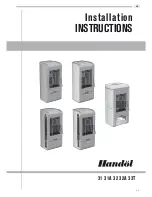
5
CDW244
30004576
It is normal to see flat spots on painted surfaces of the
stove. The flat spots on the paint surface indicate the
hotter surfaces of the stove, and is caused by the heat
radiating through the paint. It is also expected that shiny
spots caused by friction from the packaging materials,
will disappear during the curing of the stove.
SO:
1. Remember to ventilate well.
2. Allow the stove to cure before burning for long peri-
ods at high temperatures.
3. Flat spots on the painted surfaces are normal.
4. Shiny spots on the paint surface before burning is
normal.
5. Call your dealer if you have any questions.
Building a Fire
1. Open inlet air control fully.
2. Place a small amount of crumpled paper in the
stove.
3. Cover the paper with a generous amount of kindling
in a teepee fashion and a few small pieces of wood.
4. Ignite the paper and close door. If fire dies down
substantially, open door slightly.
5. Add larger pieces of wood as the fire progresses be-
ing careful not to overload. Do not fill firebox beyond
firebrick area. An ideal coal bed of 1” to 2” should be
established to achieve optimum performance.
6. This unit is designed to function most effectively
when air is allowed to circulate to all areas of the
firebox. An ideal means of achieving this is to rake a
slight (1” to 2” wide) trough in the center of the coal
bed from front to back prior to loading the fuel.
7. Once fuel has been loaded, close the door and open
air inlet control fully until fire is well established (ap-
prox. 10 minutes) being careful not to overfire.
8. Readjust air inlet control to desired burn rate. If
excessive smoke fills firebox, open air inlet control
slightly until flames resume and wood is sufficiently
ignited. While a basic rule of thumb is “closed-low”,
“1/2 way - medium” and “fully open-high”, refer to the
Inlet Air Control Settings chart.
9. When refueling, adjust air control to the fully open
position. When fire brightens, slowly and carefully
open the door. This procedure will prevent gases
from igniting causing smoke and flame spillage.
10.Add fuel being careful not to overload.
Inlet Air Control Settings
Desired
Inlet
**Approx.
Burn Setting
Air Setting
BTU Output
Low
Closed Fully
10,600
Med / Low
1/4 Open
12,118
Med / High
3/4 Open
19,413
High
Fully Open
26,100
Never use gasoline, gasoline-type latern fuel, ker-
osene, charcoal lighter fluid or similar liquids to
start or ‘freshen up’ a fire in this heater. Keep all
such liquids well away from the heater while it is
in use.
Glass Care
The following use and safety tips should be observed.
1. Inspect the glass regularly for cracks and breaks. If
you detect a crack or break, extinguish the fire im-
mediately and contact your dealer for replacement.
2. Do not slam door or otherwise impact the glass.
When closing doors, make sure that logs or other
objects do not protrude and impact the glass.
3. Do not clean the glass with materials which may
scratch (or otherwise damage) the glass. Scratches
on the glass can develop into cracks or breaks.
4. Never attempt to clean the glass while unit is hot. If
the deposit is not very heavy, normal glass clean-
ers are adequate with a plain, nonabrasive scouring
pad. Heavier deposits may be removed with the use
of a readily available oven cleaner.
5. Never put substances which can ignite explosively
in the unit since even small explosions in confined
areas can blow out the glass.
6. This unit has an airwash system, designed to reduce
deposits on glass.
Replace glass only with high temperature Robax
Pyroceram of the proper size and thickness.
Gasket Replacement
After extensive use, the sealing material which provides
glass and door seal may need to be replaced if it fails
to sustain its resilience. Inspect glass and door seal pe-
riodically to ensure for proper seal. If gaskets become
frayed or worn, replace immediately.
Contact your dealer for approved replacement parts.
The following steps should be followed for glass gasket
replacement:
1. Ensure appliance is not in operation and has thor-
oughly cooled.
2. Remove screw and glass clip.
3. Lift glass out from glass clip.
4. Remove old gasket and clean glass.
5. Replace new gasket starting at the bottom of glass
working along edges, being sure to center gasket
channel on glass.
6. Trim to length and butt ends together.
7. Replace glass in door, being sure not to over-tighten
screw and clip.






































